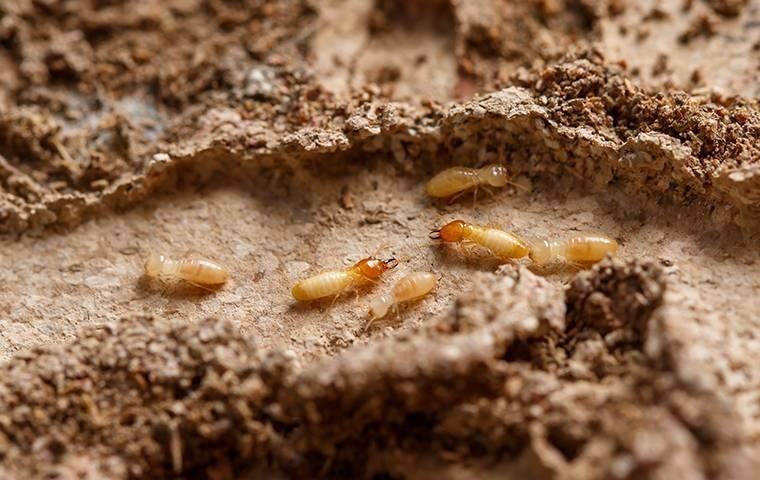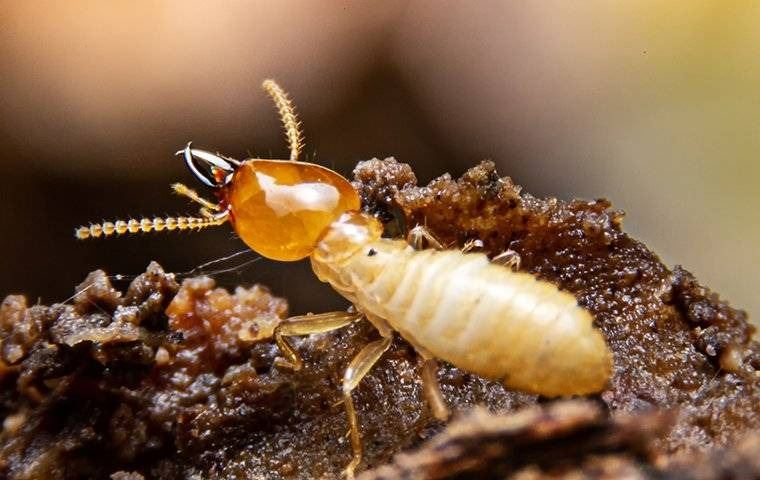
Let's Chat About Termites In Greensboro
Silent, sneaky to the point of being almost invisible, and costing Americans over two billion dollars a year in repair costs, termites have been a nightmare for homeowners in our part of the country for many years.
In nature, termites fill an all-important slot in the ecosystem, doing the job of head recyclers, and transforming old and diseased trees into rich soil.
Termites feed on cellulose and help to accelerate the natural decay of old and diseased trees. Once inside the walls of your home, those cellulose-loving proclivities make termites a foe to beware of.
Termites are nocturnal, coming up into the walls of your house through the ground and destroying the structural integrity of your home for months, sometimes years, before you notice any signs of a termite infestation.
Termites are communal insects, centering their lives around the needs of the colony, which often contains hundreds of thousands of members. The colony's core is the queen, in charge of everything happening to and by the members of her nest and tasked with laying eggs that'll hatch into nymphs.
The majority of the colony members consist of worker and soldier termites who take care of, protect, and supply the entire colony with food. Once the colony grows too large for local resources, the queen produces swarmers, termites capable of reproduction and sporting wings. Swarmers are the multitude of flying termites we see after late spring and early summer rains, flying in search of a good place to start a new colony.
Termite species vary in appearance, food preferences, and habits but identifying the exact species of Greensboro termites infesting your home or property is the key to a well-designed termite treatment plan.
Let's take a look at the types of termites common in North Carolina, signs of termite damage to watch out for, what your options are when it comes to termite control, and if the DIY approach fails, where to find reliable pest control in Greensboro.


Different Types Of Termites That Can Be Found In Greensboro
There are over 45 species of termites in the United States, but in North Carolina, we're likely to run into subterranean termites (eastern subterranean being most common), Formosan termites, and drywood termites.
- Subterranean termites are the smallest in size, averaging barely 1/8 of an inch long, with creamy white to dark brown long, cylindrical bodies. In nature, subterranean termites live in large underground colonies quartered in underground nests, which often have hundreds of thousands of members. Besides the sheer strength of numbers, subterranean termite infestations have the advantage of not being discovered for months, if not years, since they come up into your house from below and stay almost completely hidden within the structure itself. In our beautiful state, subterranean termites are the most common species and responsible for the majority of damage done to our homes.
- Formosan termites are a relatively new invasive termite species, native to Asia and first seen in the United States in the early 1950s. They are a variety of subterranean termites, building nests in the ground and forming mud tubes to make their way to the wood they feed on. Formosan termites have expanded their presence to more than half the country thanks to their aggressive behavior (they will attack and displace native termite species) and huge nests with thousands of soldier termites. Formosan termites are one of the larger species, often reaching a length of over 1/2 an inch, with long, narrow bodies that are usually creamy white or brown. They are easy to identify by the shape of the heads of their soldier cast. Unlike eastern subterranean termites with rectangular heads, Formosan termite heads are rounded on the sides and tapered towards the front.
- Drywood termites are not as common in North Carolina as subterranean termites, but thanks to their taste for dry wood, they are often a more significant threat to our homes. The lumber that holds up our houses is dried to a lower moisture percentage that prevents checking and twisting, making it a perfect snack for drywood termites. Drywood termites are 3/8 to 1 inch long with long, oval-shaped bodies that are creamy white to dark brown. Their colonies are usually much smaller than other termite species, rarely numbering more than 25,000 members. Unlike most other termite species, drywood termites do not have a soldier or worker caste, with those tasks falling on the immature termites living in the colony.
Recognizing the exact species and the habits of the termites in Greensboro attacking your home will allow you to pick the proper termite treatment to eliminate them and keep them from coming back.
A liquid treatment soaking into the ground will not do much against a non-subterranean termite species, and the amount of treatment designed to take care of a 25,000-member drywood termite colony will fall far short in dealing with a 500,000-member nest of Formosan termites.
How Much Damage Can Termites Cause?
Termites spend their lives in the pursuit of growing, feeding, or protecting their colony. They do not sleep or stop to discuss politics. Termites tunnel, eat, and feed their young 24 hours a day.
A single eastern subterranean termite will eat about 20% of its weight in cellulose each day. Multiply that by 350,000 members sharing the colony, and the damage they produce can be pretty significant.
Structural members of our homes rely on wood cross-sectional strength to support the roof over our heads. Termites tunneling through beams and joists in the walls and ceiling of our homes weaken and eventually destroy their structural integrity.
While sporting larger numbers, subterranean termites tunnel through the wood along the grain, forming intricate patterns. Drywood termites, on the other hand, chew across the grain, creating large voids in the lumber, which are much more detrimental to the structural strength of our homes.
Natural Ways To Make Your Property Less Attractive To Termites
The key to avoiding large repair bills caused by termite damage is ensuring they don't see your house as a delicacy on the menu. If that fails (we're not likely to get rid of the lumber our homes are built from to avoid sparking termite interest), making our houses as impregnable to these little engines of destruction as possible will go a long way in keeping termites outside of our walls.
- Seal up cracks and crevices in your outside walls and foundation. Termites can squeeze through an opening less than 1/16 of an inch in size.
- Repair plumbing leaks immediately to avoid tempting termites with easy access to water.
- Make sure standing water does not accumulate around the perimeter of your home.
- Keep basements and crawl spaces well-ventilated to avoid offering termites the high moisture environment they crave.
- Don't store firewood next to the walls of your home; termites are commonly found in freshly cut wood and will make their way across and into your walls in time.
- Check window and door screens to ensure they fit tight and are in good repair to avoid letting swarmers into your house.
- Inspect rarely used areas such as attics and crawl spaces for signs of a termite infestation.
- Make sure to adequately treat any wood that comes in contact with the ground.
- Install termite shields around the perimeter of your home.
Spotting a termite infestation without the benefit of training or previous experience is very difficult, which is a huge part of why termites manage to inflict so much damage on our homes, to begin with.
While the preventative measures listed above will put you miles ahead of the curve, the old saying, "when it comes to termites, it's not a question of if, it's a question of when," holds very true.
Hundreds of homeowners in Greensboro make the awful discovery of termites gnawing through the walls of their homes every year. Considering the likelihood of an infestation and the astronomical costs of the repair bills, it might be worth considering a yearly termite preventative inspection by an experienced Greensboro termite control professional.
What's The Best Way To Get Rid Of Termites In My House?
At Go-Forth Home Services, we've been helping Greensboro residents keep their homes free of termites for over 63 years. We use only environmentally friendly, green, and EPA-registered "reduced-risk" products to clear the invading pests out of your Greensboro home while making sure not to endanger your health or the health of your loved ones.
Our technicians will start with an inspection looking for signs of a termite infestation. If they find termites on the property, we will design a treatment plan to rid your home of adult insects and neutralize the eggs to avoid a reinfestation. Once that's taken care of, we'll work with you to create an effective strategy to ensure you'll never have to deal with termites in your home again.
If your Greensboro home has a termite infestation, get in touch with us for a free quote and to learn more about our residential and commercial pest control services in Greensboro.
Customer Reviews
-
“He spent time educating us about "pests" and provided information regarding services with GoForth.”- Joyce C.
-
“Texted me before coming. Worked with me playing musical rooms with my dogs. I'll see how things are.”- Constance E.
-
“Amazing response time, reasonable prices, great customer service. Tevin was thorough and confident in his plan to fix our horrendous fire ant problem. We have had negative experiences with prior exterminators and probably waited way too long to call Go-For”- Ashley T.
-
“- Toya B.
We have been customers for almost 7 years for a reason. Our technician is the best. He always knows exactly how to address whatever pest has decided to bother us. We have referred them to many of our neighbors. Well worth the cost not to have to worry a
” -
“Answered all my questions and I felt their pricing was very reasonable.”- Deborah J.
-
“Brian went above and beyond what was expected, and I hope I get him again as my technician for future services!”- Tam L.
-
“He was thorough with inspecting and treating our home, which I really appreciate, and he took the time to answer my many questions.”- Jasmine B.
-
“Love the detailed summary and pics of what he did and saw! And did I mention how wonderful Olivia was to get us all set up?!!”- Beechy A.


Over the years, we’ve boiled down our mission to a core set of values:
-
Give A CrapDelight others by owning your role and saying yes. Take pride in how you appear & act & every other detail of the job. Be on time, attentive, & enthusiastic. Act as if the buck stops with you on every aspect of the job.
-
Chase PerfectionChase Perfection, knowing full well we will not reach it, but along the way we will catch excellence. Have a sense of urgency; Go-Forth Time - right now might be the only time you have to get it right.
-
Dig Deeper
Be an action-oriented professional that makes decisions based on evidence rather than stories & assumptions. Stay curious. Data can speak for itself.
Understand the cause of the fire rather than rushing to extinguish it.
-
Fight For SimplicityKeep it simple & consistent. Focus on how things should be done every time.
-
Face It, Fix ItConfront challenges directly and address issues head-on. A bias for action and powerful conversations drive our progress. It’s about getting it right rather than being right.
-
Grow!Growth is our purpose. Growing as people & growing our business.